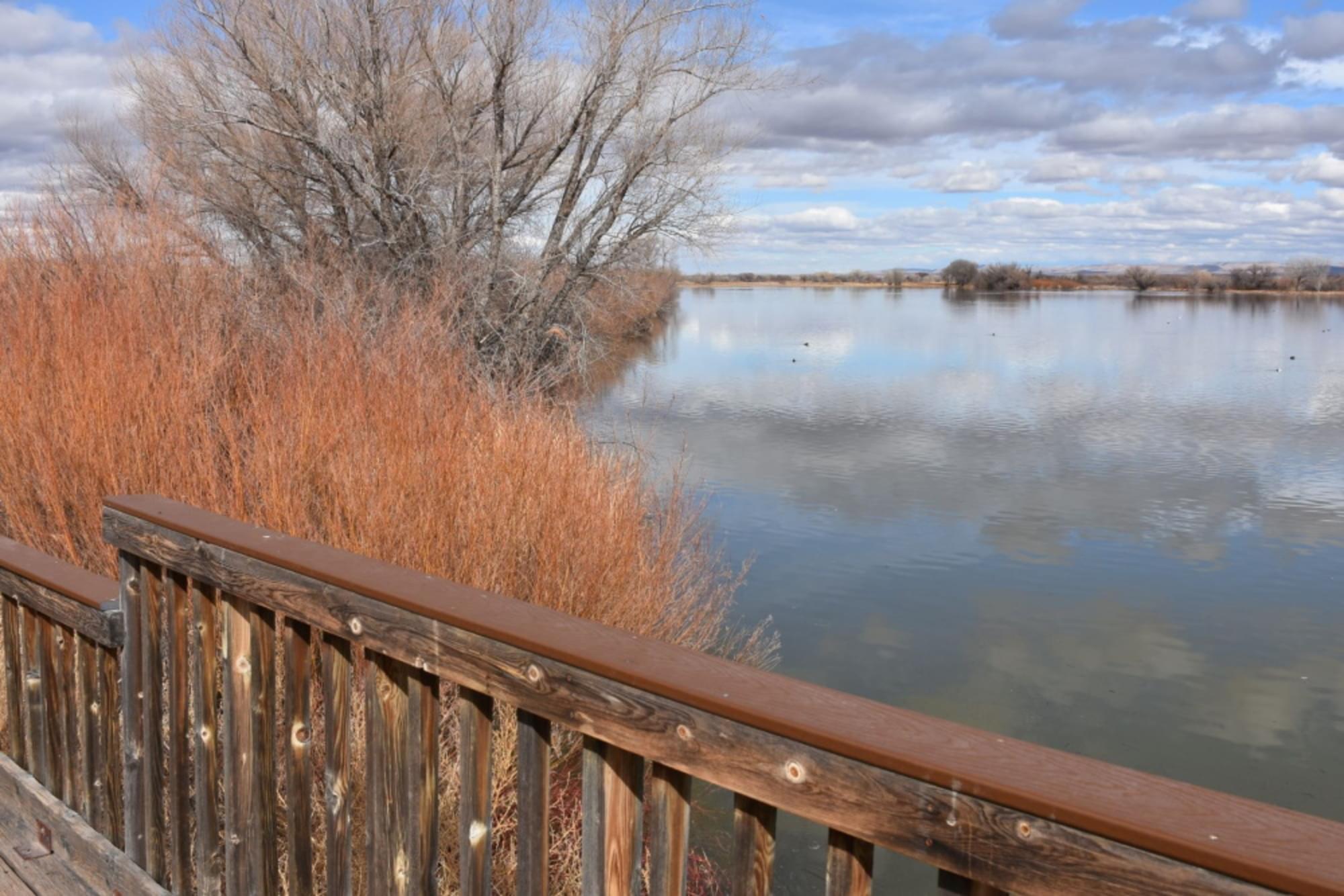Bosque del Apache NWR--Dabbler (formerly Marsh) Deck

Bosque del Apache NWR--Dabbler (formerly Marsh) Deck
San Antonio, New Mexico 87832
Bosque del Apache National Wildlife Refuge websiteFriends of Bosque del Apache NWR website
Bosque del Apache NWR Important Bird Area (Audubon) website
Habitat! Guide to Bosque del Apache NWR booklet
Bosque del Apache National Wildlife Refuge map
Tips for Birding
Traveling south on the Auto Tour Loop, somewhat more than half a mile from the intersection with the Main East-West Road, to the left (east) is a water depth gauge and mouth of pipe underneath the Tour Loop to the Elmendorf Ditch. This may be considered the northernmost point of the first specific hotspot of the South Loop: the Dabbler and Diver Deck, formerly called the Marsh Deck. Though the dirt maintenance road directly ahead is closed to visitors, you can pull to the edge of the loop road at the gauge to view the field to the east and southeast, as willow and common reed line the western edge of the field prevent that field’s examination from the Tour Loop. The willow and reed themselves may hide Sora, Virginia Rail, House Finch, Dark-eyed Junco, White-Crowned Sparrow, Song Sparrow, Spotted Towhee, and Red-winged Blackbird. Between the willow/reed and the Tour Loop, a grassy area sometimes yields Western Meadowlark. Birds here may be recorded for the comprehensive Bosque del Apache NWR hotspot, the South Loop hotspot, or the Dabbler Deck hotspot; however, do not record all your refuge or South Loop birds as being sighted from the deck.
A hundred yards or so south of the water gauge, the deck parking area lies to the left (east) of the Tour Loop. The wooden deck, which includes a bench, overlooks a field managed as a seasonal wetland. Lighting is best in the afternoon, with the sun behind you. In late fall, the field begins to be flooded from the north, attracting waders such as Lesser Yellowlegs, along with Snow Goose, Ross’s Goose, Canada Goose, Cackling Goose, Sandhill Crane, and dabbling ducks; among the latter, Northern Pintail and Mallard are usually the first to arrive, with Northern Shoveler, Gadwall, American Wigeon, and teal coming a bit later. The field is lowest in the southwest, directly in front of the deck. As the water in this area becomes deeper in early winter, diving ducks such as Lesser Scaup, Canvasback, Redhead, Ring-necked Duck, Ruddy Duck, Common Goldeneye, Bufflehead, and Hooded Merganser begin to appear, as do Pied-billed Grebe, American Coot, and, in late winter, Neotropic Cormorant. Bald Eagle commonly watch the waterfowl from cottonwoods lining the flooded field’s east bank. Entering spring, the field (which in winter has all the appearance of a lake or pond) is drained, in the process creating an excellent feeding area for wading birds such as Great Egret and Snowy Egret.
Birders should examine the cottonwoods, cattails, and sunflowers directly south of the deck, extending to the south edge of the parking area. Here you may observe many of the same species that frequent the willows and reeds to the north, plus seasonally Ladder-backed Woodpecker, Northern Flicker (Red-shafted), American Kestrel, Say’s Phoebe, Pine Siskin, Lucy’s Warbler, and Yellow-rumped Warbler.
Finally, before continuing down the South Loop, it is often worth taking a moment to scope cottonwoods lining the Elmendorf Trail’s west side, across the Loop road from the deck.
About this Location
Dabbler Deck is a stop on the Auto Tour on the South Loop. It was formerly named “Marsh Deck.”
Bosque del Apache National Wildlife Refuge Auto Tour Loop
About Bosque del Apache National Wildlife Refuge
See all hotspots at Bosque del Apache National Wildlife Refuge
Established in 1939 to provide a critical stopover for migrating waterfowl, the refuge is well known for the thousands of sandhill cranes, geese, and other waterfowl that winter here each year.
Situated between the Chupadera Mountains to the west and the San Pascual Mountains to the east, the 57,331-acre refuge harbors a wild stretch of the Rio Grande, a ribbon of cottonwood and willow trees visible on the landscape from distant mesas.
Petroglyphs tell the story of ancient people who lived and hunted here. The river and its diversity of wildlife have drawn humans to this area for at least 11,000 years when humans migrated along this corridor, sometimes settling to hunt, fish, and farm. Artifacts and stone tools found nearby tell us that nomadic Paleo-Indian hunters pursued herds of mammoth and bison in the valley.
Today, Bosque del Apache is part of the National Wildlife Refuge System, a national network of lands and waters set aside and managed for the benefit of wildlife, habitat, and you.
Features
Wheelchair accessible trail
Entrance fee
Roadside viewing
Restrooms on site
Content from Bosque del Apache National Wildlife Refuge website, Birding in New Mexico (National Audubon Society), and John Montgomery
Last updated March 10, 2024
